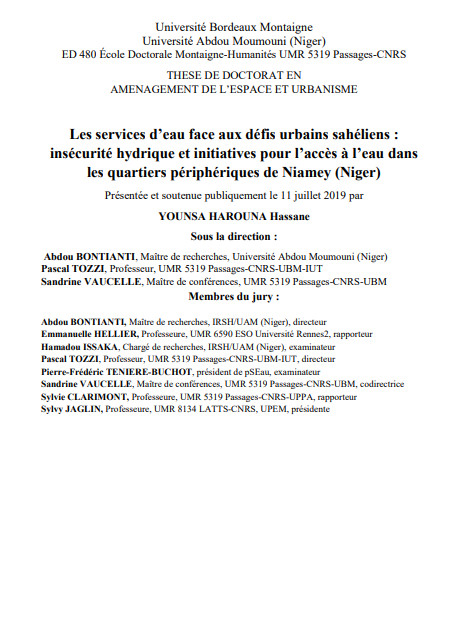Les services d'eau face aux défis urbains sahéliens : insécurité hydrique et initiatives pour l'accès à l'eau dans les quartiers périphériques de Niamey (Niger)
 |
The water services faced with the Sahelian urban challenges: Hydric uncertainty and initiatives for water access to peripheral suburbs of Niamey (NIGER)
thèse Jul 2019 ; 315 pages
Aut. Hassane Younsa Harouna
Ed. UAM - Niamey Université Bordeaux Montaigne - Pessac Université Michel de Montaigne - Bordeaux 3 - Gradignan
Téléchargeable sous format: PdF
Téléchargeable chez l'éditeur
Page de présentation d'un éditeur
Résumé:
De longues files d’attente, de seaux, de bidons jaunes, de femmes et d’enfants discutant autour des bornes fontaines. De ce point, commence l’incessant va et vient de porteurs d’eau à pied ou équipés de pousse-pousse ou encore de charrette à traction animale. Ce spectacle disparu ailleurs et qui rappelle l’histoire urbaine des pays riches comme la France constitue le quotidien des citadins des villes sahéliennes. Niamey, la capitale du Niger, située au cœur du Sahel, est le plus important foyer urbain du pays. L’accès à l’eau du service public est caractérisé par une fragmentation socio-spatiale corolaire d’une extension spatiale plus rapide que le réseau qui croît timidement au fil des années. Dans de nombreux quartiers notamment ceux situés en situation périphérique par rapport aux infrastructures (usines, réservoirs), l’accès est également marqué par des discontinuités spatio-temporelles. Elles découlent d’une urbanisation de la pauvreté, rapide et mal maîtrisée amorcée depuis plus de 50 ans. A cela s’ajoute un milieu naturel aride et chaud en compétition avec les besoins anthropiques pour le contrôle des ressources en eau. Depuis, la fragmentation dans l’accès à l’eau est devenue sans précèdent en creusant le fossé entre les branchés (raccordés) et les oubliés du réseau. Ces derniers arrivent à satisfaire leur besoin en eau grâce aux services alternatifs dérivés du réseau et ceux qui sont autonomes à savoir les forages et les mini-réseaux. Cette profusion de services d’eau émanant d’initiatives individuelles ou collectives à Niamey permet un accès hybride aux citadins. Sans cet apport, un équilibre hydrique à l’échelle de la ville ne serait pas atteint pendant les périodes de forte chaleur où, que les personnes soient branchées ou pas, la quête de l’eau requiert imagination et savoirs de la part des ménages. Ainsi, au-delà de cette situation d’insécurité hydrique que décrit cette thèse à l’échelle de l’habitat et de la ville, elle essaie de déceler les divers facteurs structurels d’ordre socio-techniques et socio-spatiaux qui rendent difficile un meilleur accès à l’eau. Les comprendre afin de les mettre en perspective dans une proposition d’aménagement de l’espace du point de l’accès à l’eau est gage d’une atténuation des effets qui pèsent lourdement sur l’offre de l’eau au Sahel comme le climat et la pauvreté. In fine, concilier urbanisation incontrôlée et une offre de services d’eau durable, spatialement et socialement et adaptée, apparait comme une réponse à ces défis urbains sahéliens donnés par l’exemple de Niamey. Abstract:
Long queues, buckets, yellow canisters, women and children talking around water fountains. From here starts the unending back and forth of the water carriers, using rickshaws, animal powered carts or eventually walking. This sight which has disappeared elsewhere and reminds the urban history of rich countries such as France, is everyday life for the dwellers of Sahelian cities. Niamey, Niger’s capital city, located in the heart of the Sahel region, is the country’s most important urban area. The access to public service water is characterized by a socio-spatial fragmentation consequence of a faster spatial extension than the extension of the network which is timidly growing year after year. In many districts, mainly in those having a peripheral location regarding infrastructures (factories, reservoirs), the access is also marked by socio-temporal discontinuities. They come from an urbanization of poverty, quick and badly initiated for more than 50 years. To that, one needs to add a hot and arid natural environment, competing with the anthropogenic need for the control of water resources. From then on, the fragmentation of the access to water has been unprecedented, enlarging even more the gap between the ones who are connected to the network and the ones who are not. These forgotten ones manage to satisfy their need for water using alternative services derived from the network and the ones who are autonomous manage using drillings or mini-networks. This huge amount of water services coming from individual or collective initiatives in Niamey allow a hybrid access to water for the citizens. Without this contribution, the hydric balance at the scale of the city wouldn’t be reached during heatwaves where, whether connected to the network or not , the quest for water requires imagination and know-how from the families. So, beyond this situation of hydric uncertainty described by this thesis at the scale of habitat and town, it also tries to detect the different socio-economical and socio-technical structural factors which make better access to water a problem. To understand these factors so as to put them into perspective in a space lay-our proposition of the point of access to water is a proof of the reduction of the effects which weigh heavily on the availability of water in the Sahel such as heat and poverty. In fine, conciliating uncontrolled urbanization and a lasting offer of water services, spatially and socially adapted seems to be an answer to these Sahelian urban challenges given by the example of Niamey.
Pays concerné: |
Editeurs/Diffuseurs: |
|
UAM
-
Université Abdou Moumouni de Niamey - Niamey - Niger |
Université Bordeaux Montaigne - Pessac |
Université Michel de Montaigne - Bordeaux 3 - Gradignan |
En cas de lien brisé, nous le mentionner à communication@pseau.org